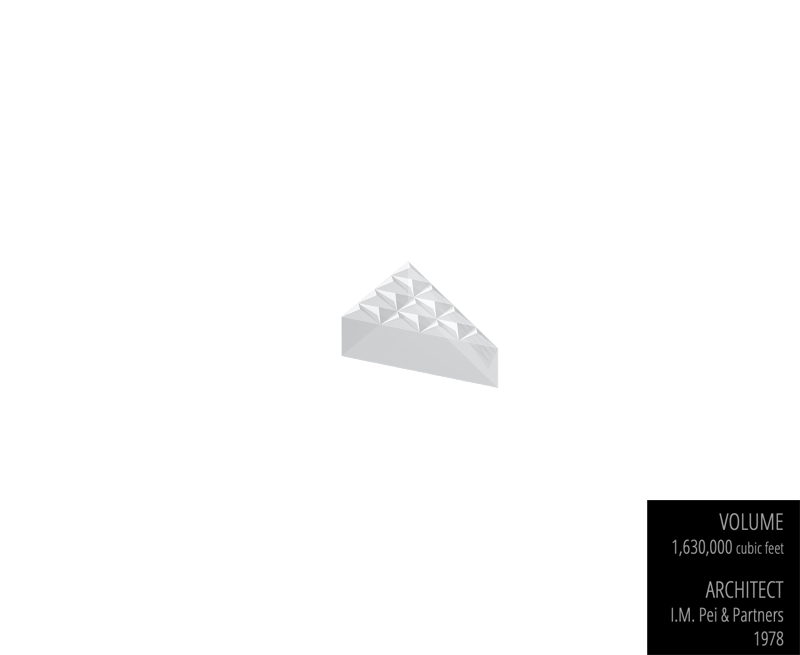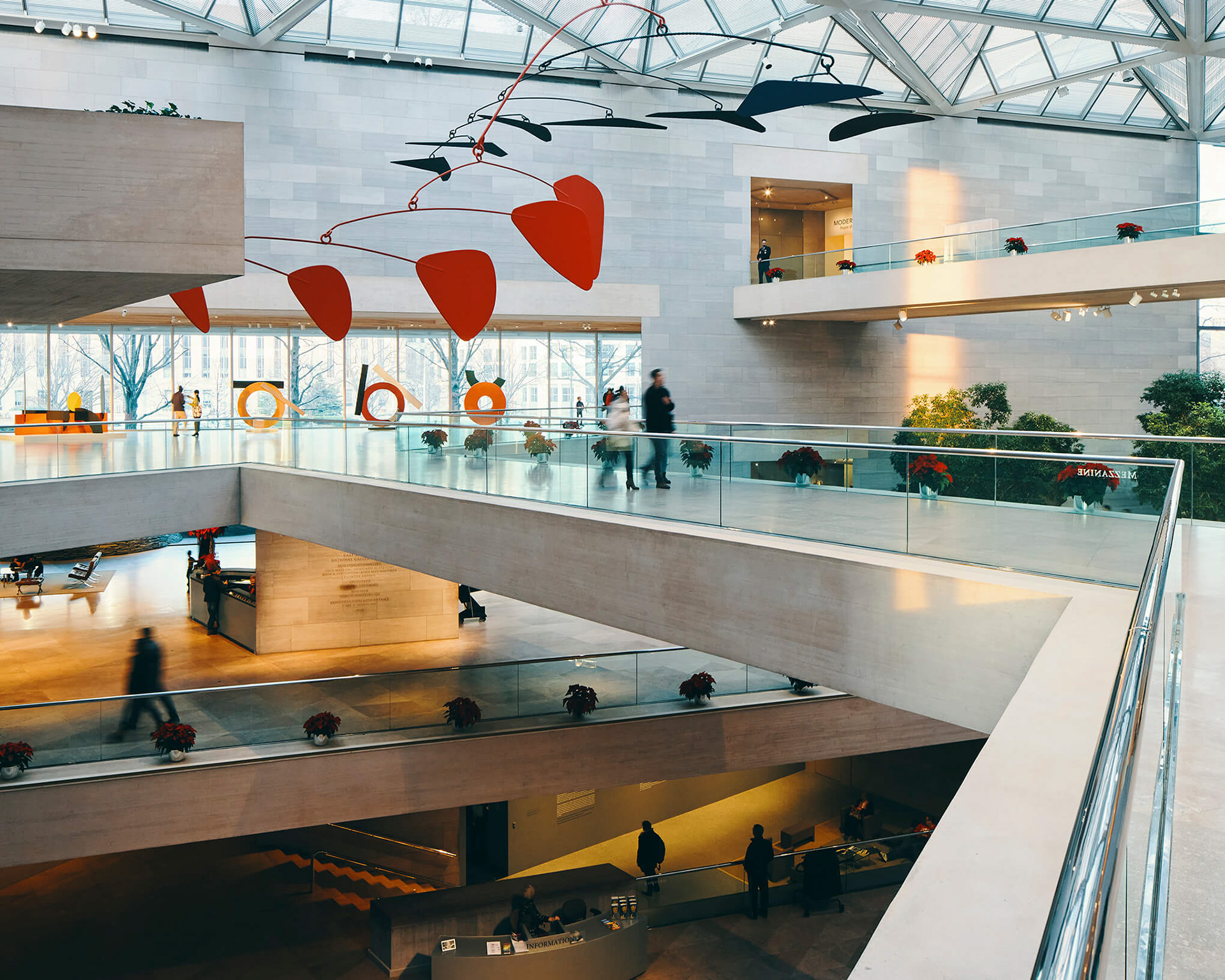Picture this: You're walking down the bustling streets of Washington D.C., and suddenly you stumble upon a masterpiece of modern architecture that seems to whisper stories of creativity and innovation. Welcome to the National Gallery of Art East Building, a place where art meets architecture in the most extraordinary ways. This iconic structure isn’t just a museum; it’s a testament to human ingenuity and artistic brilliance. If you’re a lover of art, history, or even just good design, this is the ultimate destination for you.
Now, before we dive headfirst into the nitty-gritty details, let me tell you why this place is such a big deal. The East Building isn’t your ordinary museum. Designed by none other than the legendary architect I.M. Pei, this building has been turning heads since it opened its doors in 1978. It’s like stepping into a gallery that’s as much of an artwork as the pieces it holds inside. From its geometric shapes to its sleek lines, every corner of this building tells a story.
And here’s the kicker – it’s not just about the architecture. The East Building houses some of the most breathtaking modern and contemporary art collections in the world. We’re talking about works by legends like Jackson Pollock, Mark Rothko, and Georgia O’Keeffe. It’s a place where you can lose yourself in the beauty of art while marveling at the brilliance of the structure that houses it. So, buckle up, because we’re about to take a deep dive into the world of the National Gallery of Art East Building.
Table of Contents
- The Architecture of the East Building
- Design Concept and Inspiration
- The Art Collection: A Journey Through Time
- I.M. Pei: The Visionary Behind the Vision
- The Visitor Experience: What to Expect
- The Legacy of the East Building
- Conservation Efforts: Preserving the Past
- Impact on Modern Architecture
- The Future of the National Gallery of Art
- Conclusion: Why This Place Matters
The Architecture of the East Building
The National Gallery of Art East Building is often referred to as a "sculpture in stone," and for good reason. Its architecture is a masterclass in geometric design, featuring triangles, trapezoids, and hexagons that create a sense of fluidity and movement. The building’s unique shape was born out of necessity – the plot of land it sits on was an awkward trapezoid, and I.M. Pei took this challenge and turned it into a work of art.
One of the standout features of the East Building is its use of Tennessee pink marble, which gives the structure a warm, inviting glow. The material was chosen not only for its aesthetic appeal but also for its durability. Walking through the building, you’ll notice how the architecture enhances the experience of viewing art. The spacious galleries, high ceilings, and natural light all work together to create an environment that’s both inspiring and calming.
Design Elements That Stand Out
Here are some of the key design elements that make the East Building so special:
- Geometric Shapes: The use of triangles and trapezoids creates a dynamic and innovative space.
- Natural Light: Skylights and large windows allow natural light to flood the galleries, enhancing the viewing experience.
- Material Choice: The Tennessee pink marble gives the building a unique identity and ties it to its surroundings.
Design Concept and Inspiration
When I.M. Pei was commissioned to design the East Building, he faced a unique challenge: how to create a structure that would complement the existing West Building while standing on its own as a modern masterpiece. His solution was to embrace the irregular shape of the site and turn it into an asset. By dividing the space into two main sections – one triangular and one trapezoidal – he created a layout that was both functional and visually striking.
Pei’s design was also inspired by the idea of creating a museum that would be a destination in itself. He wanted visitors to feel like they were stepping into a world of art and imagination. The result is a building that feels both intimate and expansive, offering a variety of spaces for different types of art and experiences.
The Art Collection: A Journey Through Time
Of course, no discussion of the East Building would be complete without talking about the incredible art collection housed within its walls. The museum is home to over 3,000 works of modern and contemporary art, including paintings, sculptures, photographs, and more. Some of the most famous pieces in the collection include Jackson Pollock’s “Autumn Rhythm (Number 30),” Mark Rothko’s “No. 14,” and Georgia O’Keeffe’s “Black Cross, New Mexico.”
What makes the East Building’s collection so special is its diversity. You’ll find works by both established masters and emerging artists, representing a wide range of styles and movements. Whether you’re a fan of abstract expressionism, pop art, or minimalism, there’s something here for everyone.
Highlights of the Collection
Here are some of the must-see pieces in the East Building:
- “Autumn Rhythm (Number 30)” by Jackson Pollock: A masterpiece of abstract expressionism that showcases Pollock’s signature drip technique.
- “No. 14” by Mark Rothko: A hauntingly beautiful example of Rothko’s color field painting.
- “Black Cross, New Mexico” by Georgia O’Keeffe: A stunning representation of O’Keeffe’s love for the American Southwest.
I.M. Pei: The Visionary Behind the Vision
When you think of the East Building, you can’t help but think of its creator, I.M. Pei. Born in China in 1917, Pei was one of the most influential architects of the 20th century. Over the course of his career, he designed some of the world’s most iconic buildings, including the Louvre Pyramid in Paris and the John F. Kennedy Presidential Library in Boston.
Pei’s approach to architecture was characterized by his use of modern materials and geometric forms. He believed that architecture should be both functional and beautiful, and his work often reflected a deep understanding of the cultural and historical context in which it was created. The East Building is a perfect example of his philosophy in action – a building that is both a work of art and a practical space for displaying art.
A Brief Timeline of I.M. Pei’s Career
| Year | Achievement |
|---|---|
| 1958 | Designs the Mile High Center in Denver |
| 1978 | Completes the National Gallery of Art East Building |
| 1989 | Unveils the Louvre Pyramid in Paris |
| 2006 | Designs the Museum of Islamic Art in Doha |
The Visitor Experience: What to Expect
Visiting the East Building is an experience like no other. From the moment you step inside, you’re surrounded by beauty and creativity. The building is designed to guide you through its galleries in a way that feels natural and intuitive. Whether you’re a seasoned art lover or a first-time visitor, there’s something here for everyone.
One of the things that sets the East Building apart is its emphasis on education. The museum offers a variety of programs and resources to help visitors deepen their understanding of art and architecture. You can take guided tours, attend lectures, or even participate in hands-on workshops. And if you’re looking for a more relaxed experience, there’s always the Sculpture Garden, where you can enjoy outdoor art while soaking up the sun.
Tips for Your Visit
Here are a few tips to make the most of your visit:
- Plan Ahead: Check the museum’s website for information on exhibitions, events, and hours of operation.
- Wear Comfortable Shoes: There’s a lot of walking involved, so be sure to wear shoes that can handle it.
- Take a Guided Tour: A knowledgeable guide can provide insights and context that you might miss on your own.
The Legacy of the East Building
The National Gallery of Art East Building has left an indelible mark on the world of art and architecture. It’s not just a museum; it’s a symbol of innovation and creativity. Its unique design and world-class collection have inspired countless artists, architects, and visitors over the years. And as it continues to evolve, it remains a testament to the power of art to transform and inspire.
But the legacy of the East Building extends beyond its walls. It’s a reminder of the importance of preserving and celebrating our cultural heritage. In a world that’s constantly changing, places like the East Building offer us a chance to connect with the past and imagine the future. It’s a place where art and architecture come together to create something truly magical.
Conservation Efforts: Preserving the Past
Maintaining a building as iconic as the East Building is no small feat. The National Gallery of Art is committed to preserving the building’s architectural integrity and ensuring that it remains a vibrant part of the cultural landscape for generations to come. This involves everything from routine maintenance to major restoration projects.
One of the biggest challenges in conserving the East Building is maintaining the delicate balance between preserving its original design and adapting it to modern needs. The museum has implemented a variety of strategies to address this challenge, including using sustainable materials and technologies, and working closely with experts in the field of conservation.
Impact on Modern Architecture
The East Building has had a profound impact on the field of modern architecture. Its innovative design and use of materials have influenced countless architects and designers around the world. It’s a building that challenges our assumptions about what a museum can be and inspires us to think differently about the spaces we inhabit.
But its influence extends beyond the world of architecture. The East Building has also played a role in shaping the way we think about art and culture. By bringing together art and architecture in such a unique way, it has helped to create a new model for museums that others have sought to emulate.
The Future of the National Gallery of Art
As we look to the future, the National Gallery of Art is poised to continue its legacy of innovation and excellence. The museum is constantly expanding its collection and exploring new ways to engage with its audience. From digital exhibitions to interactive installations, the possibilities are endless.
And the East Building remains at the heart of this vision. As a symbol of creativity and ingenuity, it continues to inspire and challenge those who visit it. Whether you’re an art lover, an architecture enthusiast, or just someone looking for a unique experience, the East Building has something to offer you.
Conclusion: Why This Place Matters
In conclusion, the National Gallery of Art East Building is more than just a museum. It’s a place where art and architecture come together to create something truly special. From its groundbreaking design to its world-class collection, it’s a destination that deserves a spot on every art lover’s bucket list.
So, if you haven’t already, make plans to visit the East Building. Take a tour, explore the galleries, and soak up the beauty of this incredible place. And when you leave, take a moment to reflect on the legacy of I.M. Pei and the countless artists whose work is housed within its walls. Because in the end, places like the East Building remind us of the power of art to inspire, connect, and transform.
And hey, don’t forget to leave a comment or share this article with your friends. The more people who know about this amazing place, the better! Cheers to exploring the world of art and architecture, one masterpiece at a time.


